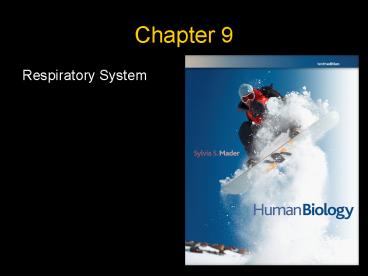Respiratory System - PowerPoint PPT Presentation
1 / 21
Title:
Respiratory System
Description:
Acute bronchitis. Infection of primary and secondary bronchi ... Passive smoke can increase a nonsmoker's chance of pneumonia, bronchitis, and lung cancer ... – PowerPoint PPT presentation
Number of Views:80
Avg rating:3.0/5.0
Title: Respiratory System
1
Chapter 9
- Respiratory System
2
Overview of the respiratory system
9.1 The respiratory system
3
What is the pathway that air follows?
8.1 Overview of digestion
- Nose
- Pharynx
- Larynx
- Trachea
- Bronchus
- Bronchioles
- Alveoli
4
What constitutes the upper respiratory tract?
9.2 The upper respiratory tract
- Nose
- Pharynx
- Larynx
5
The nose
9.2 The upper respiratory tract
- Opens at the nostrils/nares and leads into the
nasal cavities - Hairs and mucus in the nose filters the air
- The nasal cavity has lots of capillaries that
warm and moisten the air - Specialized cells act as odor receptors
- Tear glands drain into the nasal cavities and can
lead to a runny nose
6
The pharynx
9.2 The upper respiratory tract
- Funnel-shaped cavity commonly called the throat
- Tonsils provide a lymphatic defense during
breathing at the junction of the oral cavity and
pharynx
7
The larynx
9.2 The upper respiratory tract
- Triangular, cartilaginous structure that passes
air between the pharynx and trachea - Called the voice box and houses vocal cords
8
What constitutes the lower respiratory tract?
9.3 The lower respiratory tract
- Trachea
- Bronchial tree
- Lungs
9
The trachea
9.3 The lower respiratory tract
- A tube, often called the windpipe, that connects
the larynx with the 1 bronchi - Made of connective tissue, smooth muscle, and
cartilaginous rings - Lined with cilia and mucus that help to keep the
lungs clean - Tracheostomya breathing tube may be inserted
into the trachea when a person is choking due to
a blocked windpipe.
10
The bronchial tree
9.3 The lower respiratory tract
- Starts with two main bronchi that lead from the
trachea into the lungs - The bronchi continue to branch until they are
small bronchioles about 1mm in diameter with
thinner walls - Bronchioles eventually lead to elongated sacs
called alveoli
11
The lungs
9.3 The lower respiratory tract
- The bronchi, bronchioles, and alveoli beyond the
1 bronchi make up the lungs - The right lung has 3 lobes while the left lung
has 2 lobes that divide into lobules - Each lung is enclosed by membranes called pleura
12
The alveoli
9.3 The lower respiratory tract
- gt 300 million in the lungs that greatly increase
surface area - Alveoli are enveloped by blood capillaries
- The alveoli and capillaries are one layer of
epithelium to allow exchange of gases - Alveoli are lined with surfactant that act as a
film to keep alveoli open - Respiratory Distress Syndrome affects premature
infacts born without surfactant
13
Two phases of breathing/ventilation
9.4 Mechanism of breathing
- 1. Inspiration an active process of
inhalation that brings air into the lungs - 2. Expiration usually a passive process of
exhalation that expels air from the lungs
14
Inspiration
9.4 Mechanism of breathing
- The diaphragm and intercostal muscles contract
- The diaphragm flattens and the rib cage moves
upward and outward - Volume of the thoracic cavity and lungs increase
- The air pressure within the lungs decrease
- Air flows into the lungs
15
Expiration
9.4 Mechanism of breathing
- The diaphragm and intercostal muscles relax
- The diaphragm moves upward and becomes dome-shape
- The rib cage moves downward and inward
- Volume of the thoracic cavity and lungs decrease
- The air pressure within the lungs increases
- Air flows out of the lungs
16
How is breathing controlled by the nervous system?
9.5 Control of ventilation
- Nervous control
- Respiratory control center in the brain (medulla
oblongata) sends out nerve impulses to contract
muscle for inspiration - Sudden infant death syndrome (SIDS) is thought to
occur when this center stops sending out nerve
signals
17
Upper respiratory tract infections
9.7 Respiration and health
- Sinusitis blockage of sinuses
- Otitis media infection of the middle ear
- Tonsillitis inflammation of the tonsils
- Laryngitis infection of the larynx that leads
to loss of voice
18
Lower respiratory tract disorders
9.7 Respiration and health
- Pneumonia infection of the lungs with thick,
fluid build up - Tuberculosis bacterial infection that leads to
tubercles (capsules) - Pulmonary fibrosis lungs lose elasticity
because fibrous connective tissue builds up in
the lungs usually because of inhaled particles - Emphysema chronic, incurable disorder in which
alveoli are damaged and thus the surface area for
gas exchange is reduced usually due to smoking - Asthma bronchial tree becomes irritated causing
breathlessness, wheezing, and coughing - Lung cancer uncontrolled cell division in the
lungs that is often caused by smoking and can
lead to death
19
TB
- Pulmonary tuberculosisbacterial infection of the
lungs - Bacteria invade lungs, and cells form a capsule
called a tubercle - The body may destroy the tubercle or the bacteria
may be released into lung tissue - PPD Skin test that detects TB in a patient
- http//www.cdc.gov/nchstp/tb/faqs/qa.htm
20
Respiratory disorders
- Acute bronchitis
- Infection of primary and secondary bronchi
- Cough becomes deep that expectorates mucus and
perhaps pus - Bacterial infection
- May be preceded by viral URI
21
Health focus Things you should know about
tobacco and health
9.7 Respiration and health
- All forms of tobacco can cause damage
- Smoking increases a persons chance of lung,
mouth, larynx, esophagus, bladder, kidney,
pancreas, stomach, and cervical cancer - The 5-year survival rate for people with lung
cancer is only 13 - Smoking also increases the chance of chronic
bronchitis emphysema, heart disease, stillbirths,
and harm to an unborn child - Passive smoke can increase a nonsmokers chance
of pneumonia, bronchitis, and lung cancer































